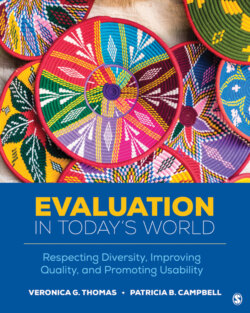Читать книгу Evaluation in Today’s World - Veronica G. Thomas - Страница 33
На сайте Литреса книга снята с продажи.
Reducing Bias
ОглавлениеThere are some ways to reduce explicit bias and to not give implicit bias the chance to operate. One strategy is for evaluators to “blind” themselves from learning a person’s gender, race, and other such characteristics when analysis is being done or decisions are being made. It is well known that observers rate the same behaviors differently based on the perceived characteristics of the subjects. For example, observers describe and rate behaviors differently based on a child’s race (i.e., Gerwitz & Dodge, 1975; Gilliam, Maupin, Reyes, Accavitt, & Shie, 2016) and on whether they think the child is a girl or a boy. Female musicians are more likely to be hired when a “blind” audition process is used, which means the hiring committee is not aware of the sex of the auditioning musicians. Accents too can make a difference. People view speakers with accents like theirs as more knowledgeable than different-accent speakers, even when the different-accent speaker is actually more knowledgeable. In 1989, Michael J. Zieky concluded that “the potential for bias in the scoring of performance tests is clear. Scorers are human and fallible. Biases both for and against members of certain groups, may be blatant or subtle but they are likely to be present” (quoted in American Association of University Women, 1995, p. 97). His point still holds.
Along with “blind” ratings, which are discussed in detail in Chapter 12, a variety of strategies have been tested to reduce bias. In an analysis of 30 studies of interventions designed to reduce implicit bias, FitzGerald, Martin, Berner, and Hurst (2019) found the most effective categories were intentional strategies to overcome biases, exposure to counter-stereotypical exemplars, identifying the self with the out-group, evaluative conditioning, and inducing emotion. Half of the studies testing appeals to egalitarian values found them to be effective while the other half didn’t. The largest number of studies tested an intervention focused on engaging with others’ perspectives, but fewer than a third of the studies found it to be an effective intervention. Training may help to reduce bias as well. Morewedge and colleagues (2015) found that research participants exposed to one-shot training interventions, such as educational videos and de-biasing games that taught mitigating strategies, exhibited significant reductions in their biases immediately and up to three months later.
The following are some implicit bias training resources.
The Kirwan Institute has a series of four short, free modules on implicit bias. The modules are Understanding Implicit Bias, Real-World Implications, Understanding Your Own Biases, and Mitigating Unwanted Biases. See http://kirwaninstitute.osu.edu/special-announcement-implicit-bias-training-available/.
Duke University has an online teachers’ workshop on overcoming implicit bias. See https://blogs.tip.duke.edu/teachersworkshop/overcoming-implicit-bias/.
The Institute for Healthcare Improvement also provides information and resources on how to reduce implicit bias in health care. See http://www.ihi.org/communities/blogs/how-to-reduce-implicit-bias.
There are ways to reduce our own biases and those of others, but implementing them can be a challenge. As Tenney (2017, p. 54) explains, “Most white people indicate that they have no racial bias, that they treat everyone equally, that they ‘don’t see race,’ and even that they are better than average at not being racially biased.” She asks what it will take for a critical mass of white people to move from being passively not racist to being actively antiracist. In the following activity, readers will hear what three people, two white and one Black, who work to reduce bias and racism say about the challenges tied to working with white people on antiracism, reflect on their response to readings, and if they choose share their responses with others.
